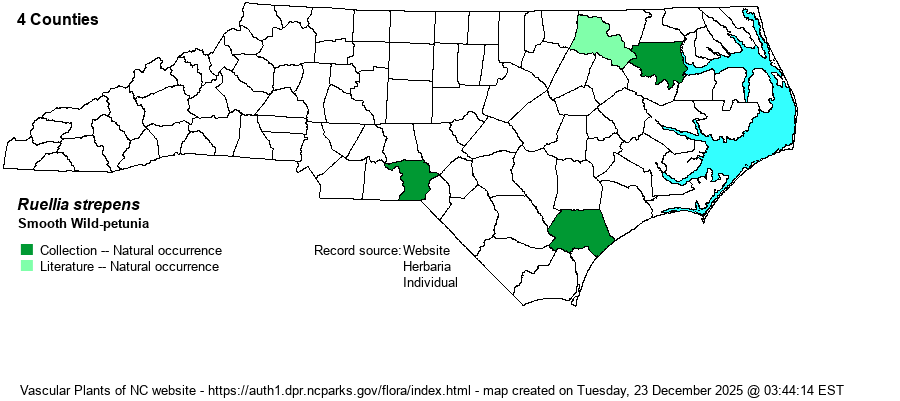| Author | L. | |
| Distribution | Remarkably disjunct range in the state, known from collections in three distant counties -- Bertie (along the Roanoke River), Pender, and Richmond; the latter site is within the eastern edge of the Piedmont (Pee Dee River). Also from Halifax County, with an iNaturalist photo from July 2021. There is a vetted iNaturalist set of photos from Buncombe County, but it is not known if this is a natural site. The species was not discovered in NC until 1970.
This is a widespread Midwestern species, found in most counties in the central Mississippi River and Ohio River regions. It ranges into much of the central Appalachians, but eastward only sparingly to NJ, NC, and SC. | |
| Abundance | Very rare in the eastern half of the state; all or nearly all of the five known sites are believed still extant. This is a State Endangered species. | |
| Habitat | This is a species requiring rich, high pH soil. The NC sites are in Wet Marl Forests (Pender County), openings along natural levee brownwater forests (Bertie County), and edges of a floodplain forest/base of a Basic Mesic Forest on gabbro (Richmond County). The habitat for the Halifax site is described as a "Nice southern sugar maple calcareous ravine forest to the south with Agrimonia parviflora and Aesculus". | |
| Phenology | Blooms from May into late summer, and fruits shortly after flowering. | |
| Identification | This is a quite smooth and robust Ruellia, growing to 2-3 feet tall, much taller than the other NC species. It may have a few branches or be unbranched. The scattered opposite leaves usually have a short petiole, and the blades are fairly large, about 4 inches long and 1-1.5 inches wide, ovate to lanceolate, with entire margins. The flowers are essentially only from axils in the middle of the stem, usually singly at an axil and with a short stalk. The flowers are large, about 2 inches long and about 1-1.25 inches across the front, being lavender to light purple in color. No other Ruellia in NC approaches this one in size, and hardly any others even are over 1.5 feet tall. They are more pubescent, and the common R. caroliniensis has darker purple flowers from the upper leaf axils. To see this species, you likely will have to travel out of state, though it certainly must lurk in a few other rich soil places in the state. | |
| Taxonomic Comments | None
| |
| Other Common Name(s) | Smooth Ruellia, Limestone Wild-Petunia | |
| State Rank | S1 | |
| Global Rank | G4G5 | |
| State Status | E | |
| US Status | | |
| USACE-agcp | FAC link |
| USACE-emp | FAC link |

